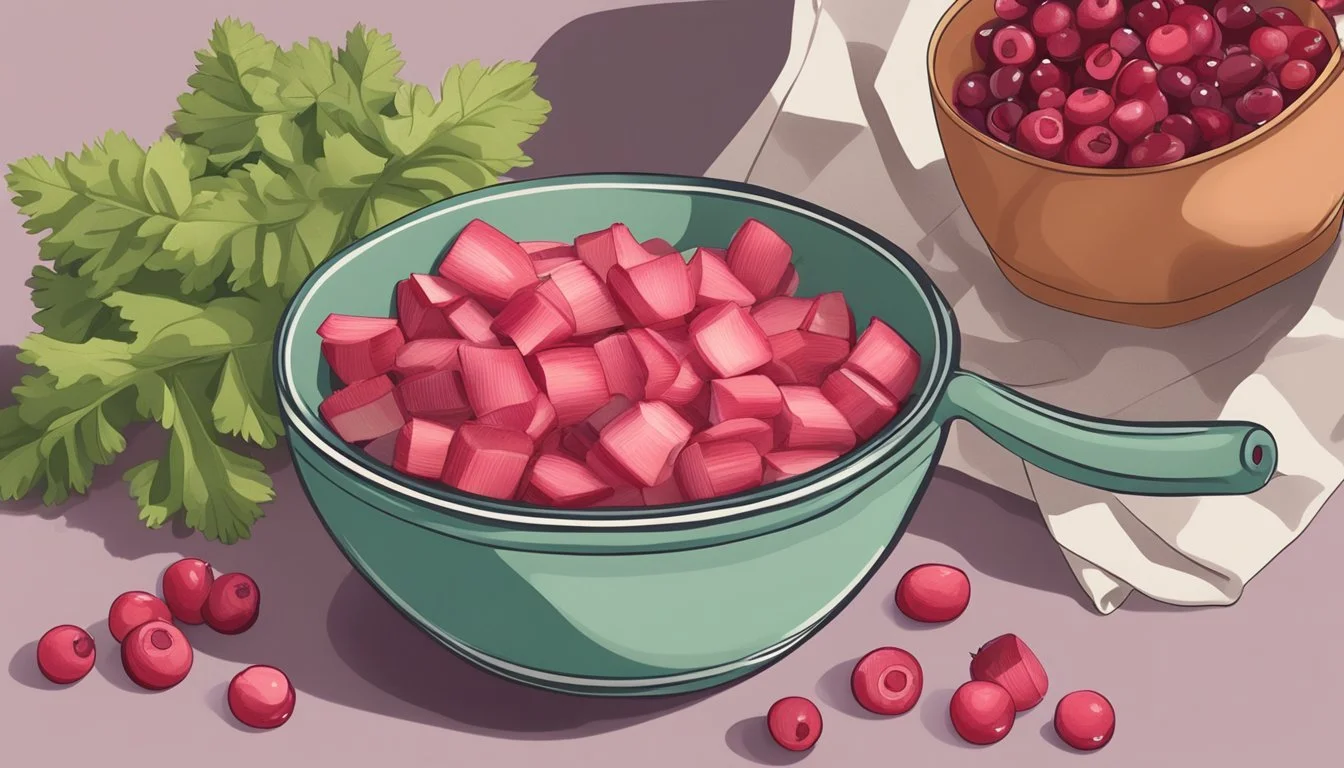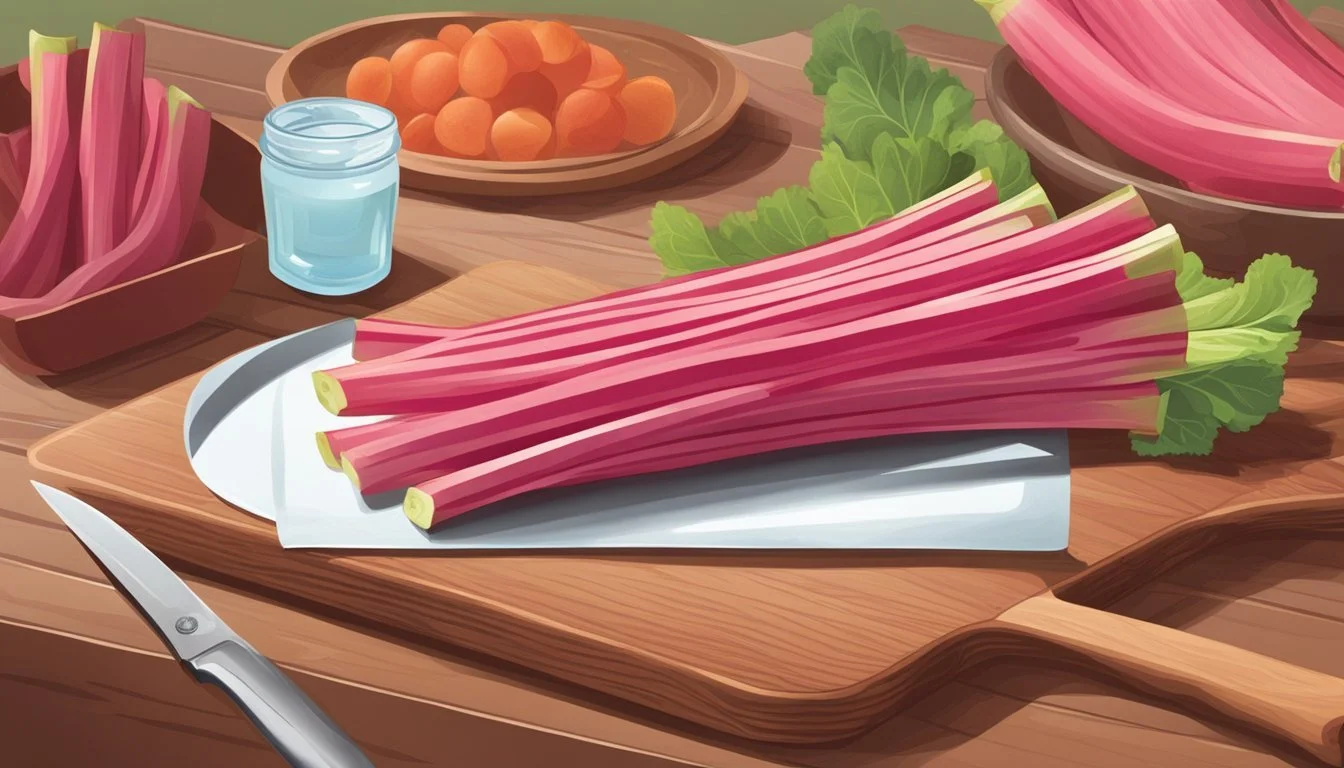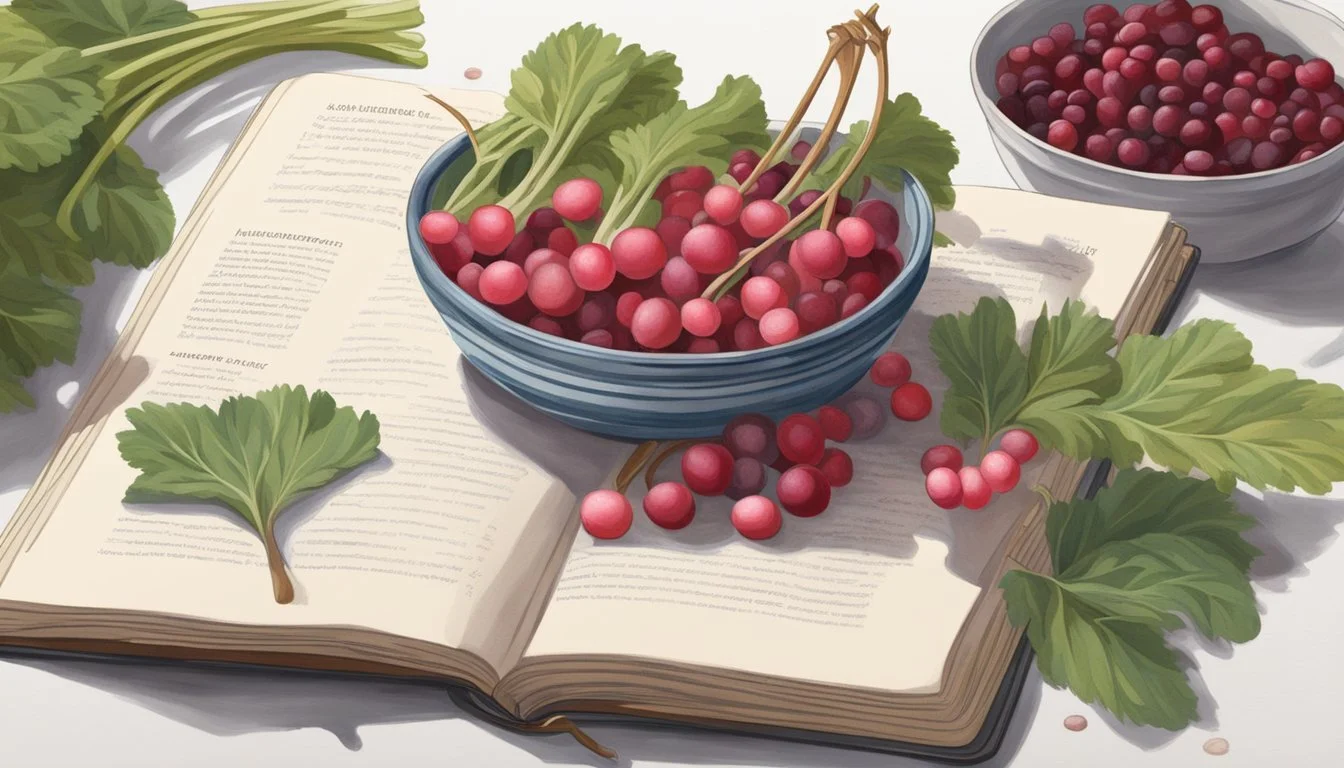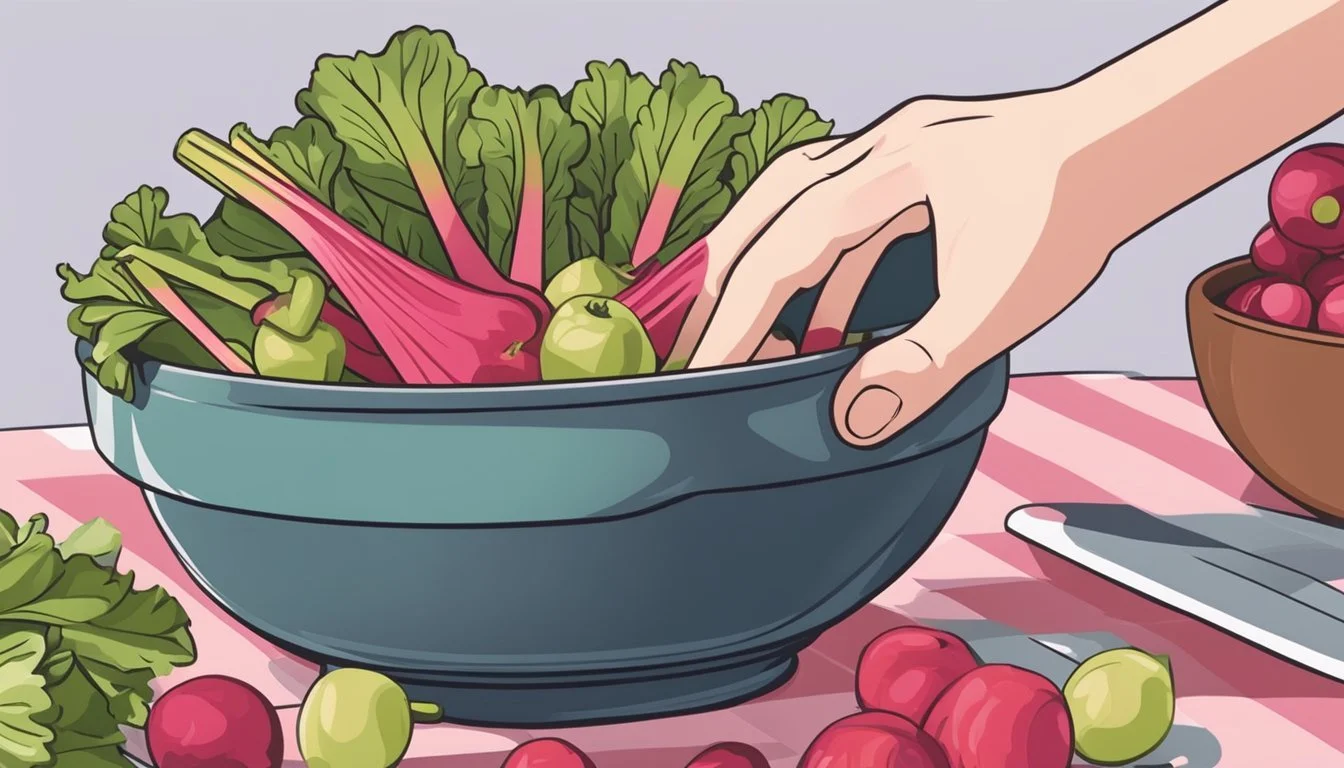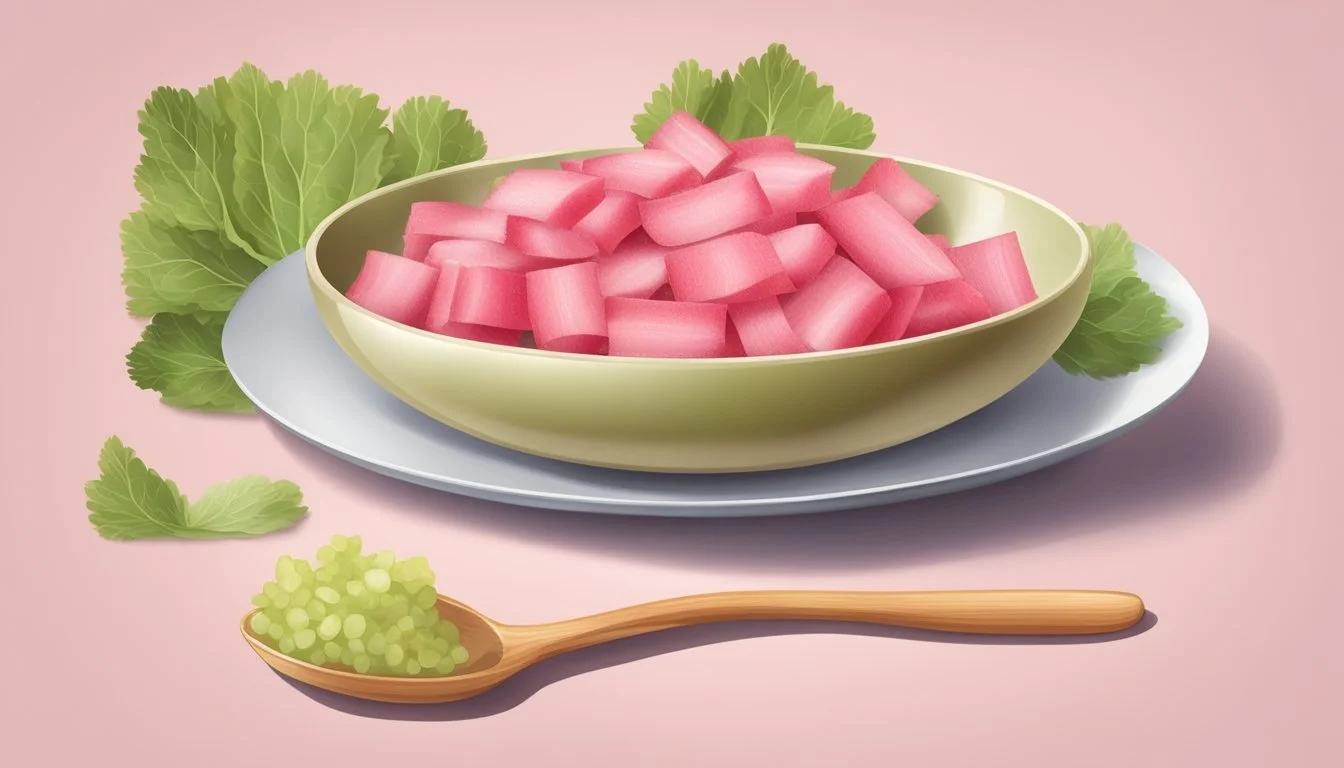How to Substitute Rhubarb for Cranberries
A Guide to Swapping Tart Flavors
In the culinary world, creative substitutions can often save a dish when an ingredient is out of season or unavailable. Cranberries, with their tart and tangy flavor, make an excellent substitute for rhubarb in various recipes. While rhubarb offers a distinctively sharp taste and fibrous texture, cranberries bring a similar acidic bite that balances sweet and savory dishes alike.
One must consider the textural differences and flavor profiles when substituting cranberries for rhubarb. Rhubarb's fibrous structure breaks down with cooking, offering a soft texture, while cranberries tend to burst and create a more gel-like consistency. Therefore, adjustments in preparation technique and additional sweeteners might be necessary to achieve the desired outcome in the final dish.
Cooking experts often experiment with ingredient substitutions to exploit the complementary flavors. In the case of cranberries replacing rhubarb, they can provide a vibrant hue and a pleasing tartness to pies, crumbles, and sauces. Chefs suggest tasting the dish throughout the cooking process to ensure a balance of flavors that aligns with the original intent of the recipe featuring rhubarb.
Understanding Rhubarb
Rhubarb is a versatile vegetable known for its tart flavor and bright red stalks, which are the only edible portion of the plant. This section delves into its nutritional profile, when it is best to enjoy rhubarb, and how it can be used in the kitchen.
Nutritional Benefits
Rhubarb is a source of vitamin C, which is important for immune function, fiber, beneficial for digestion, and calcium, necessary for bone health. The plant is also rich in potassium, which helps regulate blood pressure levels, and it contains antioxidants that may offer health benefits by combating oxidative stress in the body.
Vitamin C: Aids in immune defense and skin health.
Fiber: Supports digestive health.
Calcium: Essential for bone strength.
Potassium: Important for heart and muscle function.
Antioxidants: Protect cells from damage.
Seasonal Availability
Rhubarb is typically available in the spring and early summer. Its peak season can vary based on the geographical location, but it usually spans from April to June. Fresh rhubarb is best enjoyed during these months, although frozen rhubarb can be found year-round.
Culinary Uses
Rhubarb is primarily used in sweet applications, such as pies, tarts, and jams. Its tartness complements the sweetness in desserts, and it's often paired with strawberries. Rhubarb can also be used in savory dishes, where it adds a unique flavor profile. When cooking rhubarb, sugar is commonly added to balance its tartness.
Desserts: Pies, tarts, crumbles, and jams.
Savory Dishes: Sauces for meat or added to salads.
Pairings: Complements strawberries, ginger, and citrus flavors.
Cranberries: An Overview
Cranberries are small, tart, red berries known for their unique flavor profile and health-promoting properties. They are utilized in a variety of culinary contexts and are often associated with their juice form.
Health Properties
Cranberries are recognized for their vitamin C content and their potential role in preventing urinary tract infections (UTIs). They exhibit anti-inflammatory qualities, which can contribute to overall health benefits. Studies have consistently linked cranberry consumption with a reduced risk of UTIs, attributing this effect to the presence of proanthocyanidins, which hinder bacteria from attaching to the urinary tract walls.
Diverse Applications
Cranberries are versatile in their applications, ranging from raw, cooked, to processed forms including cranberry juice, dried cranberries, and sauces. Cranberry juice is commonly consumed as a beverage and in blends, while dried cranberries offer a convenient, sweet, and tangy snack. They can also be incorporated into baked goods, salads, and as a compote, providing a flavorful contrast in savory and sweet dishes.
Substituting Rhubarb for Cranberries
When substituting rhubarb for cranberries, one must consider both the similarities in flavor and the differences in texture. Additionally, cooks should adjust the amount of sweeteners like sugar or honey (What wine goes well with honey?) to achieve the desired sweetness.
Similarities in Flavor
Cranberries and rhubarb share a tart flavor profile, which makes rhubarb a suitable substitute in recipes demanding that zesty punch. Often, dishes that utilize cranberries benefit from the sharpness they provide, an attribute that rhubarb can mimic. To fine-tune the tartness to match that of cranberries, a cook may introduce a small amount of lemon juice to the rhubarb.
Texture Considerations
Rhubarb has a fibrous texture that becomes soft and tender when cooked. Cranberries, on the other hand, tend to burst and create a more gelatinous consistency when stewed. When using rhubarb as a substitute, a chef may need to chop it finely to replicate the smaller size of cranberries and consider cooking time to achieve a similar consistency.
Cooking Adjustments
Adjusting sweetness is crucial when substituting rhubarb for cranberries due to rhubarb's inherently sharper edge. It typically requires additional sweeteners to balance its tart flavor. Here is how one can adjust sweeteners:
Sugar: Increase the amount of sugar incrementally, tasting as you go.
Honey: Add honey for a more nuanced sweetness; start with small quantities to avoid overpowering the dish.
Other Sweeteners: Alternative sweeteners like agave nectar or maple syrup can also be used to achieve the desired level of sweetness.
Cooking adjustments also include assessing the moisture content of the dish, as rhubarb can release more water than cranberries, which may necessitate a reduction in other liquid ingredients.
Recipe Modifications
When substituting cranberries for rhubarb in recipes, one must adjust quantities and sweetness levels to achieve a similar balance of tartness and flavor profile that rhubarb naturally provides.
Sweet Dishes
For desserts such as pies, crisps, or jellies that typically feature rhubarb, cranberries can serve as an effective substitute due to their similar tartness. However, since cranberries are more tart than rhubarb, they should be used in slightly lower quantities. For example:
Rhubarb Pie: Reduce cranberries by about 1/4 and increase sugar by 1/8 to compensate for tartness.
Rhubarb Crisp: Use cranberries in a 3:4 ratio to rhubarb and add an extra tablespoon of sugar to the topping.
Using cranberries in sweet sauces or jams requires additional sugar as well. For rhubarb sauce or jam recipes, one can follow these recommendations:
Rhubarb Recipe Cranberry Substitute Additional Sugar 1 cup rhubarb jam 3/4 cup cranberries 2 tbsp extra sugar 1 cup rhubarb sauce 3/4 cup cranberries 1-2 tbsp extra sugar
For baked goods where rhubarb provides a moist texture:
Reduce liquid in the recipe slightly as cranberries have less moisture.
Cranberries may need to be chopped or partially mashed to mimic the texture of softened rhubarb.
Savory Dishes
In savory dishes like chutneys and sauces, cranberries can replace rhubarb without significantly altering the taste profile, particularly if the dish already contains a fruit element.
Rhubarb Chutney: Substitute cranberries directly but start with 3/4 the amount of rhubarb called for and adjust for taste.
Savory Sauces: Add mild sweetness to the cranberries to balance their sharpness, such as a touch of honey or maple syrup.
Keep in mind the cooking times may vary slightly due to the difference in texture between rhubarb and cranberries. Cranberries tend to cook faster and may need less time on the heat to reach the desired consistency.
Substitute Pairing
When using rhubarb as a substitute for cranberries, one must consider the flavor profile and texture of the replacement. The tartness and color are vital attributes to match, ensuring a similar impact on the overall dish.
Berries as Substitutes
Berries offer a good flavor resemblance to cranberries, with tartness that complements sweet dishes. The following table outlines suitable berry substitutes:
Berry Substitute Flavor Profile Best Used In Raspberries Tart and sweet Baked goods, sauces Strawberries with a touch of citrus (e.g., lemon juice) Tartness balanced with sweetness Pies, jams, compotes Sour cherries or tart cherries Pronounced tartness Pies, preserves, desserts
Strawberries may require the addition of a sour component, such as lemon juice, to achieve the desired tartness. Raspberries, being inherently tart and sweet, can be a direct one-for-one substitute. Sour or tart cherries closely mimic the acidity and tanginess of cranberries, making them an excellent choice for most recipes.
Citrus and Other Fruits
Citrus fruits and certain other fruits can bring the requisite tartness to recipes, often with added brightness.
Lemon and grapefruit: Can be zested or juiced to add tartness to sweet dishes.
Quinces: Their tartness and unique flavor are suitable for cooked dishes.
Tart apples: These can be cooked down to match the texture of stewed cranberries.
Pomegranate seeds: Provide a burst of tartness and a pop of color for fresh applications or garnishes.
Adding lemon zest to strawberries or grapefruit juice to a sauce can enhance the tart flavor profile, making it more akin to that of cranberries. Quinces, though less common, have the necessary tartness and hold up well when cooked. Tart apples, such as Granny Smith, can be stewed to resemble the consistency of cranberry sauce. Pomegranate seeds offer a texturally distinct but visually similar garnish with a burst of tart flavor.
Enhancing Flavor and Sweetness
When substituting rhubarb with cranberries, one must carefully balance the tartness with sweetness to closely match the intended flavor profile of the original recipe.
Using Sweeteners
Sugar is the most straightforward sweetener to counteract the tartness of cranberries. It is recommended to start with an equal amount of sugar to cranberries and then adjust to taste. Honey can also be used as a natural alternative, bringing a different flavor complexity to the dish. Approximately 3/4 cup of honey can replace 1 cup of sugar, but this can vary based on the honey's sweetness and personal taste preference.
Leveraging Spices and Citrus
Cinnamon adds a warm, spicy note to the cranberries, complementing their inherent tartness. A small pinch can go a long way in enhancing the overall flavor. For a fresh, zesty twist, lemon juice or zest from other citrus fruits can brighten the dish and add a level of depth that mimics rhubarb's unique tang. A table showing suggested starting ratios for spices and citrus is helpful:
Ingredient Starting Ratio Cinnamon 1/4 teaspoon per cup of cranberries Lemon Juice 1 tablespoon per cup of cranberries
Adjustments can be made based on the sourness of the cranberries and the desired flavor intensity.
Cooking Techniques for Substitution
When substituting rhubarb for cranberries, chefs employ strategic adjustments during the cooking process to achieve a balance in flavor and texture that resembles the desired cranberry profile in the final dish.
Baking with Rhubarb
In baked goods such as pies, crumbles, muffins, tarts, and cakes, rhubarb can replace cranberries by matching the tartness and structure that cranberries typically provide. Since rhubarb is more fibrous and less juicy than cranberries, adjustments in moisture content are necessary.
Pies and Crumbles: Reduce added liquids marginally, as rhubarb will release less juice than cranberries during baking. Increase sugar slightly if the tartness is too pronounced.
Muffins and Tarts: Chop rhubarb finely to distribute its tart flavor evenly, resembling the cranberry experience. Consider pre-cooking rhubarb with a touch of sugar before adding to the batter.
Cakes: Mix rhubarb into the batter as you would with cranberries, but be mindful of the longer cooking times that rhubarb may require to soften.
Preparing Rhubarb for Sauces
For sauces, rhubarb can be stewed down to a consistency akin to that of cranberry sauce, creating a similar texture and flavor profile to be used as a preserve or accompaniment.
Stewing Technique: Simmer chopped rhubarb with sugar and a splash of water until it breaks down into a sauce-like consistency, appropriate for spooning over desserts or meat dishes.
Flavor Adjustment: Introduce a small amount of lemon juice to enhance the tartness or orange zest for added depth, replicating the berry's unique zing. Sweeten according to taste, keeping in mind rhubarb's natural sourness.
Serving and Presentation
When substituting rhubarb for cranberries, presentation and serving methods can greatly influence the enjoyment of the final dish. Rhubarb’s vibrant color and tartness offer visual appeal and a flavor profile that enhances a variety of desserts and meals.
Dessert Toppings
Rhubarb, when used as a topping, provides a visual and taste contrast that appeals to the senses. For instance:
Muffins: A rhubarb compote makes an excellent topping for muffins, delivering a tart kick that complements the sweetness.
Ice Cream: A spoonful of stewed rhubarb adds a refreshing tang to creamy vanilla ice cream, creating a delightful balance of flavors.
Incorporation in Meals
Incorporating rhubarb in place of cranberries within meals requires careful balance of its distinct tartness with other components:
Desserts: Rhubarb can be sliced and layered in desserts, providing a tart flavor that contrasts well with sugary components.
Fresh Fruit Salad: Diced rhubarb mixed into a fresh fruit salad introduces a tangy twist and complements sweeter fruits nicely.
Muffin Recipe: Folding chopped rhubarb into a muffin batter creates a burst of tartness with each bite, making for a more complex and satisfying flavor profile compared to cranberries.
Storage and Preservation
When substituting rhubarb for cranberries, understanding how to store and preserve these ingredients ensures their flavor and texture are optimal for use. Both these tart items offer different storage methods aligning with their seasonal availability.
Storing Substitute Ingredients
Frozen Cranberries: To store cranberries as a rhubarb substitute, one can freeze them to maintain their freshness. They should be spread out on a baking sheet to freeze individually and then transferred to freezer-safe bags. This method prevents the cranberries from clumping together and maximizes their shelf life.
Dried Cranberries: For an alternative that is always readily available, dried cranberries offer a convenient substitute. They should be stored in a cool, dry place in a sealed container to extend their usability.
Dried Rhubarb: While less common, dried rhubarb can be used in place of fresh stalks when out of season. Storage for dried rhubarb operates on the same principle: keep it in an airtight container in a dry area to preserve its quality.
Making the Most of Seasonality
Availability plays a pivotal role in the storage and preservation of both rhubarb and cranberries. Rhubarb typically flourishes in spring, with the season's end marking the time to freeze or dry excess stock.
Frozen Cranberries: They are not just a seasonal pleasure; with proper freezing techniques, they can be enjoyed year-round. One can stock up during their peak season in late autumn, applying the same freezing method mentioned above.
Dried Cranberries and Rhubarb: Both maintain their flavor and are easily stored. Their dried form is advantageous as they are non-perishable and have an extended shelf life, making them a convenient alternative when fresh produce is not in season.
Health Considerations
When substituting rhubarb for cranberries, one should be aware of the nutritional differences and potential allergens to make informed dietary choices.
Tracking Nutritional Intake
Rhubarb is lower in calories and carbohydrates compared to cranberries but does not offer the same vitamin C or antioxidant richness. Cranberries are known for their high vitamin C content and antioxidant properties, which contribute to their health benefits including urinary tract health and potential disease prevention.
Vitamins and antioxidants:
Cranberries: High in vitamin C and antioxidants.
Rhubarb: Contains some vitamin K and calcium but less vitamin C.
Manganese is a mineral found in both cranberries and rhubarb, playing a role in bone development and nutrient metabolism.
Manganese content:
Cranberries and Rhubarb: Both contain manganese, with cranberries having a higher content.
A comparative analysis of nutritional data can guide individuals looking to balance their dietary intake when substituting these ingredients.
Understanding Allergies and Intolerances
Allergies to rhubarb or cranberries are rare, but they can occur. Substituting one for the other must be done with caution, especially for those with known food sensitivities or allergies.
Allergens:
Cranberries: May trigger allergies in individuals sensitive to salicylic acid.
Rhubarb: Its leaves contain oxalic acid which is toxic; only the stalks should be consumed.
To ensure a safe substitution, individuals with food intolerances or allergies should consult with a healthcare provider or dietitian.
Additional Tips and Advice
When substituting rhubarb for cranberries, cooks should be mindful of the differences and similarities between the two. Rhubarb is typically more fibrous than cranberries and has a stronger tart flavor. To mitigate this, one can finely chop the rhubarb or cook it down slightly to soften its texture.
Cranberries often come in dried form, which is excellent for an energy snack or as an add-in for baked goods. When looking for a fresh substitute, fresh rhubarb can impart a similar tartness but may need extra sweetening. Here are some quick tips:
Sweeten Accordingly: Rhubarb may require more sugar or a sweetener to balance its tartness.
Texture Consideration: If the recipe requires the unique texture of dried cranberries, consider adding other dried fruits to mimic the chewiness.
Cooking Advice:
For sauces or jams, rhubarb can replace cranberries in equal measure.
Soften rhubarb by pre-cooking before adding to recipes that do not require further cooking.
Substitution Ratio: Use a 1:1 ratio when replacing cranberries with rhubarb in cooked recipes, but adjust for sweetness.
Cranberry Substitutes can also include:
Strawberries with citrus zest: For a fresh, sweet, and tangy flavor.
Raspberries or sour cherries: These can be used for their tartness and can be a closer match to cranberries in certain recipes.
When substituting, they should always have the dish's final flavor profile in mind. With a neutral but confident tone, it's clear that cooks can achieve successful outcomes with these tips.


